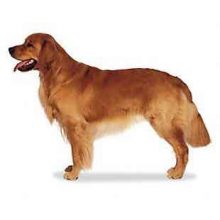Golden Retriever
Lifestyle Needs

The Golden Retriever was originally a working gun dog which retrieved game in the hunting field. The Retriever has adapted to many roles, including being a guide dog for the blind and other types of assistance dog. He is a popular family pet but requires proper socialisation as a puppy. As a largish hunting dog he needs plenty of opportunities for long walks and off lead exercise. He has a thick coat which sheds and will need grooming at least twice a week.
Genetic Diversity
(Known as Coefficient of Inbreeding: 'COI'. It should be as low as possible.)
The UK Kennel Club breed average COI is 9.4% - See 'A Beginners Guide to COI'
Gene Pool Size
(Known as Effective Population Size: 'EPS')
81.7
EPS is a measure of how many individuals are contributing genetically to a breed population. It is a measure of the size of the gene pool in a breed. Lower than 100 is considered critical by conservationists and below 50 brings a breed close to extinction. For more information see the Kennel Club article.
Health and Welfare Problems due to Conformation
(Body shape and physical characteristics)
- There are two recognisable types of Retriever. The slimmer, more athletic type is generally bred to work and should be a fit and agile dog. The other type is a slightly shorter, heavier dog favoured for showing. Bear this in mind when choosing your breeder and looking at the parents. Too much weight is harmful to a dog and prevents him having a good quality of life. Weighty dogs are also more prone to hip dysplasia.
- Prone to obesity
BVA/KC Health Schemes: www.bva.co.uk/chs
- Eye disease: Multi-focal retinal dysplasia (MRD) (litter screening); Hereditary cataract (HC) (annual testing); Progressive retinal atrophy (PRA) (annual testing); Goniodysgenesis/Primary glaucoma (G) (annual testing)
- Hip Dysplasia: breed 5 year mean score 12.8 (parents should be lower)
- Elbow dysplasia: Score of parents should ideally be 0:0 or as low as possible.
Estimated Breeding Values (EBVs) : EBVs for Hip and Elbow Dysplasia are available for this breed
www.thekennelclub.org.uk/about-ebvs
DNA Tests Available
DogWellNet and IPFD Harmonisation of Genetic Testing for Dogs (HGTD)
www.dogwellnet.com/breeds
- Progressive Retinal Atrophy (GR_PRA1)
- Progressive Retinal Atrophy (GR_PRA2)
- Ichthyosis (ICT-A)
Availability of a DNA test does not mean that it is always necessary or even desirable for breeders to use this test.
Other Breed-Specific Health Screening Schemes
- Bitches under 18 months not to produce a litter
- Bitches not to produce more than one litter in a 12-month period
Ask the breeder to show you the certificates for the above tests/screening for both parents. If any of the above tests have not been considered necessary by the breeder (and there may be good reasons), ask her to explain why.
Other Diseases Reported
(For which there are currently no genetic or screening tests for sire or dam)
- Allergic skin disease
- Heart disease: Aortic stenosis
- Arthritis
- Cancer: (the breed has a very high incidence of cancer of various types)
- Ectopic ureter
- Epilepsy
- Glaucoma
- Hypothyroidism
- Polyneuropathy
- Cranial cruciate ligament disease (CCL)
Ask the breeder about the medical history of the parents, grandparents and great grandparents. Consider carefully whether to purchase a puppy if some of these or other diseases are in the family line.
Ask about the breeder’s policy in cases of serious genetic diseases occurring to your puppy in later life. Good breeders will request to be informed of such events in order to improve future breeding decisions.
You are strongly advised to buy from a breeder who uses (or is prepared to use) the AWF Puppy Contract and Puppy Information Pack (PIP): www.puppycontract.org.uk
The breeder should also be familiar with the CFSG/DBRG Code of Practice for Dog Breeding
Or the Kennel Club’s Assured Breeders Scheme Standard and Guidance:
Standard PDF | Guidance PDF